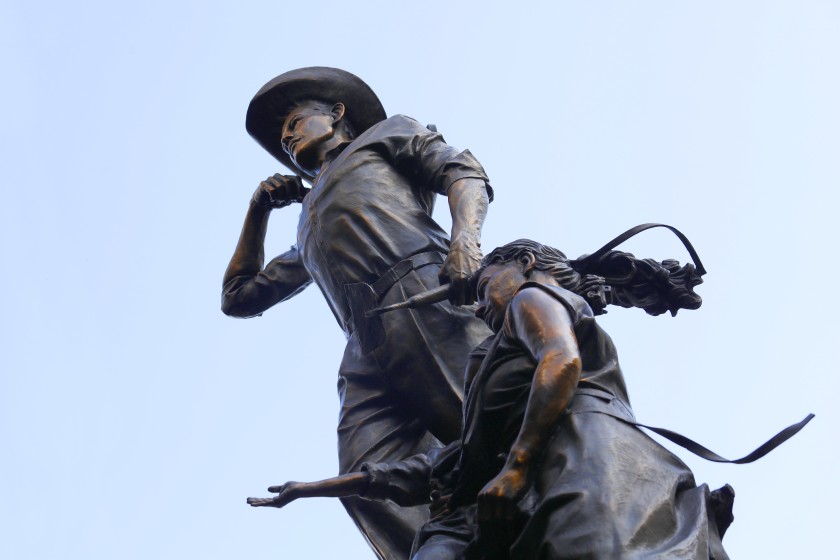
The Bracero Monument, a sculpture by Dan Medina that stands in Migrant’s Bend Plaza in downtown Los Angeles, pays tribute to the Mexican workers who temporarily migrated to the U.S. during and after World War II to help fill labor shortages.
In Migrant’s Bend Plaza in downtown Los Angeles, a new statue stands.
It measures about 20 feet tall. A bronze migrant worker holds el cortito, a short-handled hoe that required field workers to be bent over for their 10- to 12-hour shifts.
To the left of the worker, his wife holds their son, clutching a toy Ford truck in one arm while stretching out the other arm in search of his father. To the right, there’s a pile of workers’ tools and other symbols depicting how migrants were exploited.
The Bracero Monument, unveiled Sunday, was created by artist Dan Medina, 51, as part of a $3.2-million streetscape and pedestrian improvement project that also highlights Native American, African American and immigrant cultures from many L.A. communities.
A crowd of people gathered Sunday afternoon at Migrant’s Bend Plaza, near Spring Street and Cesar Chavez Avenue, for a street festival to unveil the monument.
“These men left their families to go north and endure difficult working conditions for little pay to support their families,” L.A. City Councilman Jose Huizar said in a statement, adding that his father and uncles were part of the bracero program. “It is important that we honor them, their hard work and their contributions to this country.”
Braceros were Mexican nationals who temporarily migrated to the U.S. to help fill labor shortages during and after World War II. As part of an agreement between the U.S. and Mexico, they worked on farms and fields, mines and railroads.
Huizar’s office said more than 4.5 million Mexican nationals participated in the bracero program from 1942 until 1964.
But experts have said the number could be lower, between 1 million and 2 million, because the same people returned multiple times. Contracts would range from one to six months.
‘Latino Americans’
Braceros in cowboy hats wait in an area penned by barbed wire at the Monterrey Processing Center in Nuevo Leon, Mexico, in 1956. (Smithsonian Institution / PBS)
The bracero program was praised for providing a cheap, steady supply of laborers for the nation’s growers, but critics have said that many of the workers lived in substandard conditions and that the program created unfair competition and depressed farmworkers’ wages.
“The immigrant has been demonized,” said Medina, an L.A. native of Mexican descent whose stepfather was a bracero. “Although many complain about the immigrant, if you look at history through the scope of honesty, we wouldn’t be here without their contributions.”
He interviewed dozens of braceros — the name stemming from the Spanish word for arm — and their descendants while doing research to create the monument.
A cross at the monument commemorates those who died on the job, Medina said, including 24 braceros who were killed when an open-bed truck flipped over.
A barbed wire represents the last thing workers saw when they went to bed and the first thing they saw when they woke up. A spray can represents the chemicals they were sprayed with to “fumigate them” when they crossed the border, he said.
“They were treated like cattle,” Medina said. “They weren’t free.”
The Bracero Monument borders a new mixed-use, 355-unit housing development built by Trammell Crow.



Be the first to comment